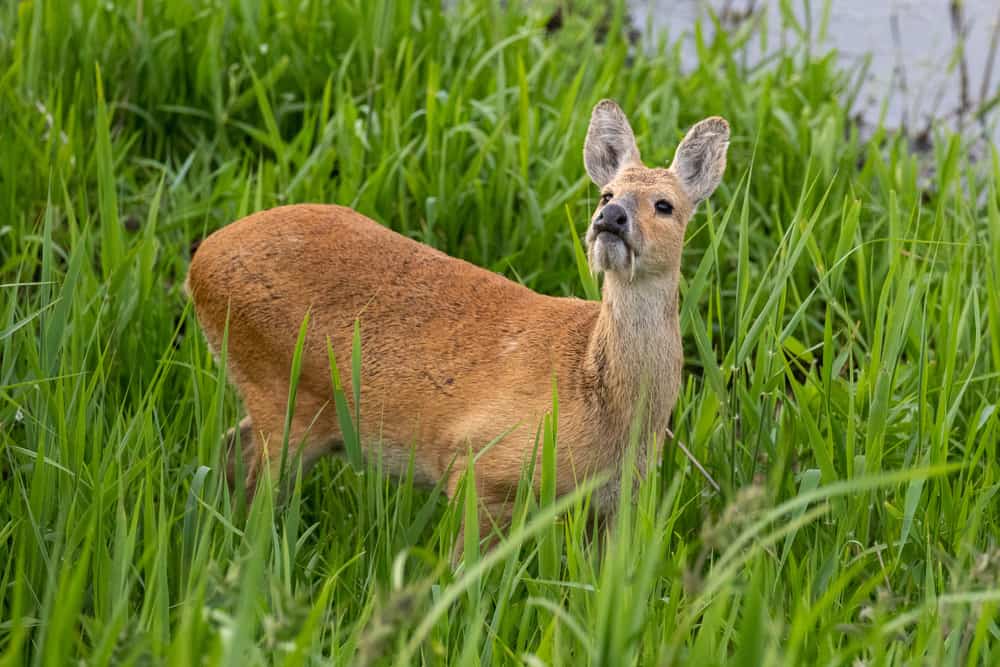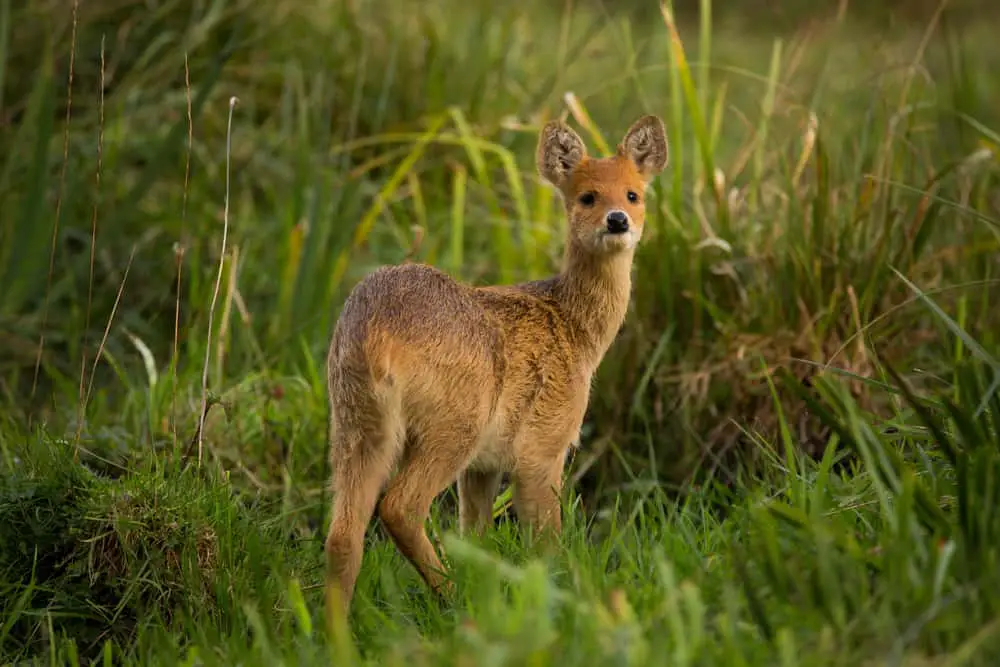Water deer (Hydropotes inermis) are a species of small, semi-aquatic deer found across Asia. The water deer is an interesting species with unique adaptations that enable it to thrive in its natural environment.
This article will discuss the ecology and behaviour of the water deer, as well as conservation efforts for this vulnerable species.
The water deer can be found living across parts of China, North Korea, South Korea and Vietnam. It inhabits wetlands including marshlands, swamps and riverbanks, and also makes use of agricultural land such as rice paddies surrounding these wetland areas.
As one of only two extant cervids native to Asia, the other being the sika deer (Cervus nippon), the water deer holds significant significance within its range countries’ ecosystems.
Unfortunately however, due to habitat destruction and hunting pressure over recent decades, populations have declined significantly and they are now listed as Vulnerable on IUCN’s Red List.

Distribution And Habitat
The water deer is a species found across parts of Asia, including China and Japan.
This unique species has two distinct morphs – one with antlers, which are the males; and one without antlers, which are the females.
Water deer have been known to inhabit habitats ranging from wetlands to grasslands and wooded areas near rivers or lakes.
They prefer locations where there is an abundance of vegetation cover and access points for entering the water.
Habitat selection plays a significant role in water deer conservation as it helps determine their population density and distribution patterns.
In addition, habitat selection is important when considering potential ecotourism activities that can be used to generate income for local communities while providing support for wildlife conservation efforts.
Therefore, understanding factors influencing habitat selection such as availability of food resources, shelter requirements, predation pressure and human disturbance levels will help inform management strategies geared towards securing viable populations of this species into the future.
Physical Characteristics
The water deer’s physical characteristics are quite remarkable. With these features, it stands out among the other species of its type. Its long ears and pale fur make it particularly unique in the animal world.
To further illustrate this point, here is a list of some of the distinguishing traits that set apart this majestic creature:
- Large antlers – These antlers can reach up to 25 cm (10 inches) in length!
- Long ears – Water deer have incredibly long ears which extend up to 15 cm (6 inches).
- Pale fur – The beautiful coloration found on their coats varies from reddish-brown to grey or even white.
- Small size – Although they appear larger than most due to their impressive antlers, water deer are actually relatively small with adults only growing up to 1 m (3 feet) tall.
This combination of physical attributes has enabled them to survive and thrive in environments where other animals may not be able to easily inhabit. This resilience makes them an important part of many ecosystems around the world and is why conservation efforts need to remain ongoing in order for future generations to benefit from their presence.
Diet And Foraging Behaviour
Water deer forage mainly on grasses, fresh foliage and aquatic vegetation. They also consume fruits, nuts, mushrooms and tubers when available. These animals have adapted to survive in a wide range of habitats from wetlands to woodlands and shrubland areas.
The diet of water deer is closely linked to their environment and the availability of resources within it. During the summer months these animals feed primarily on young shoots and leaves while during winter they switch to eating stems, bark and lichens as well as buds that are found beneath snow cover.
Different populations of water deer display different food preferences due to regional variations in habitat quality; however, this species has developed specialized foraging strategies which allow them to make the most efficient use of their resources regardless of what type of habitat they inhabit.
Reproduction And Development
The water deer, a species of great antiquity and rarity, is revered for its unique reproductive habits. With that in mind, let us take a dive into the fascinating:
- Mating Rituals: Water deer males compete with one another to win over females by means of ritualistic displays that involve jumping high out of the water and butting their heads against each other on land.
- Birthing Process: Females give birth to litters of up to four offspring after an eight-month gestation period. The young are born with soft fur covering them and can swim within hours of being born.
- Habitat Requirements: To survive as adults, water deer require habitats with shallow waters and dense vegetation cover so they can hide from predators like wolves or bears.
- Conservation Efforts: As hunting has caused dramatic declines in population numbers across much of Eurasia, conservation efforts such as captive breeding programs have been initiated in order to protect this ancient species from extinction.
With all these factors taken into consideration it is clear that the water deer requires special care if we wish to keep it around for generations to come!
Social Structure
Water deer are social animals who live in groups of up to 12 individuals, consisting of one male and several females. They can be found living near rivers and marshes, as well as wetlands within agricultural fields. Territoriality is a key aspect of their behavior; males stake out territories that may cover an area of 10-15 hectares. Females typically remain within the territory of their mate.
Mate selection is also important for water deer; males will use visual cues such as antlers and body size to assess potential mates whilst females select based on vocalizations and scent marks made by prospective partners. A comparison between territoriality and mate selection among water deer is shown in the following table:
| Territoriality | Mate Selection |
|---|---|
| Males mark territory with urine or feces | Males use visual cues (antlers/body size) to assess potential partners |
| Territories range from 10-15 hectares | Females base decisions on vocalization/scent marks |
Studies have revealed that female water deer become more selective when choosing a partner during mating season, decreasing the likelihood of infanticide occurring due to unfamiliar males entering the group. Male water deer have been observed defending their territory vigorously against intruders – this helps ensure safe access to resources necessary for survival, such as food and shelter. Therefore, it appears that both territoriality and mate selection play vital roles in maintaining order amongst water deer herds.

Interactions With Humans
The relationship between water deer and humans is complex and multifaceted. As the human population steadily increases, so do anthropogenic influences on these creatures’ habitats. From a human-centric perspective, their presence can be both beneficial or detrimental depending on one’s point of view.
On one hand, water deer are an important part of local ecosystems; they help maintain plant life by eating grasses and other vegetation, as well as provide food for predators such as foxes. On the other hand, Homo sapiens have severely impacted their natural environment through activities like deforestation and urbanization which has led to habitat loss and fragmentation:
- Negative impacts:
- Destruction of wetlands due to agricultural practices
- Unregulated hunting leading to overharvesting
- Positive outcomes:
- Creation of nature reserves in order to protect them from development projects
- Reintroduction programs that aim to restore previously lost populations
It is evident that understanding our relationships with water deer must take into account both environmental and anthropogenic pressures if we hope to conserve this species effectively in the future.
With careful management, it is possible for us to coexist peacefully while ensuring the long-term health of their populations.
Conservation Status
The conservation status of water deer has been a growing concern for many years. In particular, their population has dramatically declined due to various human activities such as habitat loss and hunting. As an endangered species, there is a need to develop effective strategies that will help increase its numbers in the wild.
Climate change also poses a serious threat to water deer populations since it can lead to extreme weather events and other changes in the environment that could affect their habitats and food sources.
To protect this species from further decline, efforts should focus on protecting their existing habitats and ensuring sustainable land use practices throughout their range. Additionally, research needs to be conducted into how climate change affects water deer specifically so that more targeted management plans can be implemented.
Interesting Facts
Water deer are an intriguing species of mammal, found only in China and the Korean peninsula. Their most distinguishable feature is the presence of tusk-like upper canines on males and some females, a trait unique to them among all other species.
Sightings reports show that water deer inhabit wetlands, marshes, and riparian habitats along lowland rivers. They have also been observed foraging for food near agricultural fields during autumn months. Migration patterns vary depending on local conditions; however, they typically move seasonally between higher elevations in summer to lower elevations in winter due to changes in temperature or availability of food sources.
Water deer rely heavily on their senses—particularly sight and smell—to detect danger from predators such as wolves and raptors. While their long legs help them escape predators by running quickly, they often use camouflage tactics like standing motionless when threatened instead. In addition, their sharp canine teeth make it possible for them to defend themselves against larger animals should the need arise.
The conservation status of water deer is currently listed as ‘Near Threatened’ by the International Union for Conservation of Nature (IUCN). Although there has not been any significant decline reported recently within its range countries, ongoing threats such as habitat loss and degradation remain a major concern for this species’ survival into the future. As such, careful monitoring and sustained efforts are needed to ensure healthy population numbers remain viable over time.
Conclusion
Water deer are a unique species found in various parts of Asia, possessing physical characteristics such as elongated canine teeth and long legs that make them well-suited to their environment.
They exhibit complex foraging behaviors, reproduce rapidly, and live in social groups.
Unfortunately, water deer have seen a decrease in numbers due to human activities such as poaching and habitat destruction.
In order to protect this remarkable species from further decline, conservation efforts must be taken seriously.
For example, by implementing anti-poaching laws and protecting the fragile habitats where water deer reside.
In addition, education initiatives can help raise awareness about the importance of conserving these animals.
By working together we can ensure that future generations will get to witness the grace and beauty of this fascinating creature living freely in its natural environment.
